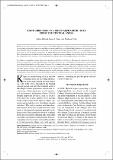Files in this item
Knot direction in a khipu/alphabetic text from the Central Andes
Item metadata
| dc.contributor.author | Hyland, Sabine Patricia | |
| dc.contributor.author | Ware, Gene | |
| dc.contributor.author | Clark, Madison | |
| dc.date.accessioned | 2015-05-12T16:01:02Z | |
| dc.date.available | 2015-05-12T16:01:02Z | |
| dc.date.issued | 2014-06-01 | |
| dc.identifier | 145020489 | |
| dc.identifier | 34e9ded3-a25c-4462-b1a8-f845f3e75a96 | |
| dc.identifier | 000348890900006 | |
| dc.identifier | 84929704445 | |
| dc.identifier.citation | Hyland , S P , Ware , G & Clark , M 2014 , ' Knot direction in a khipu/alphabetic text from the Central Andes ' , Latin American Antiquity: A Journal for the Society of American Archaeology , vol. 25 , no. 2 , pp. 189-197 . https://doi.org/10.7183/1045-6635.25.2.189 | en |
| dc.identifier.issn | 1045-6635 | |
| dc.identifier.uri | https://hdl.handle.net/10023/6637 | |
| dc.description.abstract | Khipus are knotted-string devices that were used in the Inka Empire for communication and for recording information. We recently analyzed the names and associated khipu cords in a newly discovered hybrid khipu/alphabetic text from the Central Andes. Results indicate a significant relationship in the text between knot direction and a form of social organization known as moieties, in which S-knots correspond to the upper (Hanan) moiety and Z-knots correspond to the lower (Urin) moiety. This relationship suggests that knot direction was used to indicate moiety in Andean khipus and, as such, may represent the first decipherment of a structural element in khipus since the decoding of the number system in the 1920s. | |
| dc.format.extent | 9 | |
| dc.format.extent | 1030372 | |
| dc.language.iso | eng | |
| dc.relation.ispartof | Latin American Antiquity: A Journal for the Society of American Archaeology | en |
| dc.subject | Andean archaeology | en |
| dc.subject | Epigraphy | en |
| dc.subject | Andean anthropology | en |
| dc.subject | GN Anthropology | en |
| dc.subject.lcc | GN | en |
| dc.title | Knot direction in a khipu/alphabetic text from the Central Andes | en |
| dc.type | Journal article | en |
| dc.contributor.institution | University of St Andrews. Social Anthropology | en |
| dc.identifier.doi | https://doi.org/10.7183/1045-6635.25.2.189 | |
| dc.description.status | Peer reviewed | en |
This item appears in the following Collection(s)
Items in the St Andrews Research Repository are protected by copyright, with all rights reserved, unless otherwise indicated.

